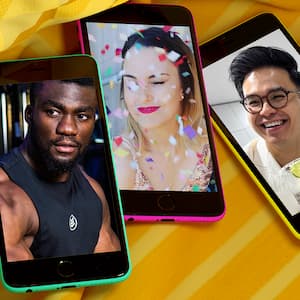If you had to flee your homeland for an unknown country, what's the one item you would take with you? That's the question being asked in , a new interactive installation being launched at the Biennale of Sydney.
A documentary piece to compliment Ai Weiwei's artwork , Belongings brings personal stories and voices to humanise the politicised topic of refugees and asylum seekers. Six refugees now living in Australia share how their treasured belongings have been a source of strength, hope and a reminder of home.
R.H., 48, Bangladesh
“I brought the embroidery work of my mother because I could not bring her. She is the most important thing I have in the world but I had to leave her alone in my country. The embroidery is a small piece of her presence that I can feel everyday. It connects me to her every time I see it and touch it. It’s the most valuable thing to me now and I keep it with me all the time. I miss my mother so much and I love her more than life itself.”
Parastoo Bahrami, 21, Afghanistan

Parastoo Bahrami hopes to start a creative enterprise through her craft of beading. Source: SBS
"Beading is something I did back home. I could not bring any of my beads with me but now I have a lot of beads here and it makes me happy. Putting the beads together to make something has allowed me to look after my emotional well-being. By making these objects I feel happy and it helps me avoid depression and mental health issues. When I am making these objects, I always think that I will have a bright future and I forget a little about my difficult past in Afghanistan. I always carry beads. Always.”
Sabina Krusevljanin, 55, Bosnia Herzegovina

Sabina Krusevljanin is a passionate supporter of refugees in Australia and globally. For over 20 years she has worked in customer services. Source: SBS
"Those glasses used to belong to my husband who was killed during the war in Sarajevo. I feel as if he is with me."
Damon Amb, 38, Iran

Damon Amb studied photography in Iran and became an accomplished artist. He arrived in Australia in 2013. Source: SBS
Lizzy Samba, 34, Papua New Guinea

Lizzy Samba is a trans advocate and health worker from Papua New Guinea. Source: SBS
"Being transgender is something refugees don’t talk about. It’s hard. My necklace is a sign of strength to empower me to speak out. I left with it and it's all I need sometimes to feel alive."
Amou Job, South Sudan

Amou Job has been a community worker in Sydney engaging families, women and children in capacity-building programs across the Western suburbs. Source: SBS
Created by SBS's Digital Creative Labs and using technology developed by Google’s Creative Lab, brings stories of displacement and hope to life in an interactive installation on from Friday 16 March until 11 June at the Biennale of Sydney, Cockatoo Island, Building 153.
Thriller airs over four weeks, exploring issues facing asylum seekers once they settle in Australia. All episodes will be available after broadcast anytime, anywhere, for free via . Join the conversation with #SafeHarbour. Watch episode one now:

